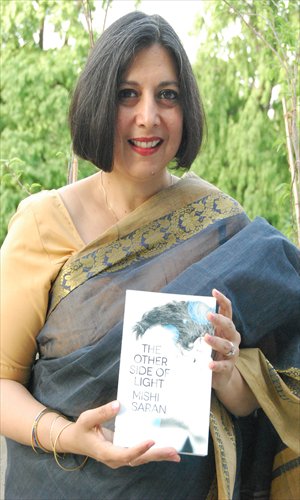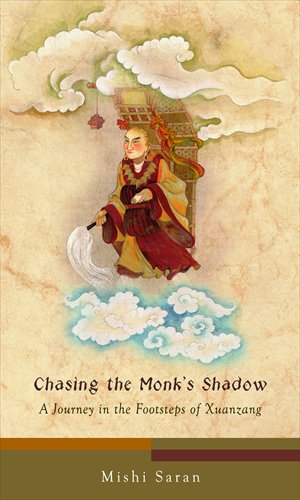Journey to the West
Mishi Saran's gentle voice makes it almost incongruous to connect her to the arduous journey along the Silk Road from China to India. And yet this is a journey she undertook, following in the footsteps of the famous Chinese Buddhist monk Xuanzang (or Hsuan Tsang) of the Tang Dynasty (618-907).
The now Shanghai-based was acclaimed for her travelogue-cum-memoir based on this experience, Chasing the Monk's Shadow: A Journey in the Footsteps of Xuanzang published by Penguin in 2005. "For me, the story began with language," Saran told the Global Times. "I like the Chinese language and I like Chinese culture."

Chinese bonds
Born in Allahabad, India in 1968, Saran spent her early childhood in New Delhi. But with her businessman father being regularly posted abroad, she later lived in Switzerland, Indonesia and the US after the age of 10.
While an undergraduate at Wellesley College in Massachusetts - "where Soong Mei-ling also studied" she pointed out - Saran read about a one-year course in Chinese and enrolled simply out of "curiosity."
Her teachers gave her the Chinese name, Sha Meizhi. "After completing the course, I still didn't know anything about China or the Chinese people, which was strange considering it's a neighbor of my native country," she said. In 1988, she started a one-semester exchange in a university in Beijing, which she then extended to two semesters.
On returning to Wellesley, Saran took more courses in Chinese history and language and a year after graduating, she went to the Hopkins-Nanjing Center in Nanjing to further her studies. "But at that time the Chinese economy was still not so well developed, so I decided to go to Hong Kong for work," she said.
There, she found a job as a journalist at the Kyodo News Agency. "I didn't know anything about journalism, and they hired me only because I could speak Chinese. I became a journalist because I always wanted to be a writer," she told the Global Times.
Six years later, Saran quit and became a freelancer. She has had articles published in a number of international publications such as the Financial Times, the International Herald Tribune, the South China Morning Post and the Asian Wall Street Journal.

Indian and Chinese history
As a young girl, Saran read the story of the monk Xuanzang and his journey to India in comic books. "But I didn't really think too much about it until many years later. I thought that his man could give me a greater insight into the connection between our two countries. And the story of Xuanzang inspired me to try to follow the monk's journey to India, and to discover more about Indian history as well as Chinese history."
She successfully applied for a travel grant of some $15,000 from Wellesley College and other funds from the Hong Kong Arts Development Council. Before setting off, she carried out research at the Chinese Academy of Social Sciences in Beijing, which has a department specializing in Xuanzang studies. This provided her with invaluable information about the exact route of Xuanzang, as well as the ancient and current names of the places he passed.
In May of 2000, Saran started out from Luoyang, Shaanxi Province, the birthplace of Xuanzang and then traveled to Xi'an (previously Chang'an), from where Xuanzang began his own journey. Over the next 12 months, Saran journeyed on foot through China, Uzbekistan, Kyrgyzstan, Pakistan and Afghanistan. On arriving at each new destination, she consulted local museums and archives for further details and clues, all the while making notes about the trip.
In July of 2001, she returned to Hong Kong because she was unable to get a visa to Pakistan. But within a week the visa came through and she flew back to Pakistan to continue the trip.
From Pakistan, she journeyed to Afghanistan, barely one month before 9/11 and which would soon become a battleground. "At that time, the Taliban was ruling the country so I could only visit Kabul. As a non-Muslim woman I was barred from traveling anywhere else in the country," she recalls.
Sadly this meant she was unable to travel the very last section of the journey in Afghanistan, between Amu Darya and Bamiyan. But Saran hopes to be able to return there one day to finish off this final leg.
Shanghai living
Fluent in English, Putonghua, French and Hindi, Saran settled down in Shanghai with her husband and two-year-old daughter in 2006 after living in South Korea for a couple of months. "At first I was reluctant to come back to China because I thought I had written my book and had got China out of my system," she said. However, the lure of Shanghai proved too much.
"If you understand this city's history, then you understand the history of modern China," she said. "I feel modern Shanghai is like an onion, with many different layers. And every time you peel it you find something else underneath."
She is currently promoting her second book The Other Side of Light. It depicts a modern Indian woman's story of love, friendship and life. "I wanted to portray a woman who is complex. Of course, love and romance is important to women, but there are many other important things. I would like to read those kind of books, but they don't exist, so I thought I would write one myself," she said.
Saturday afternoon will see the official launch of The Other Side of Light, (published by Harper Collins India) at M Glamour Bar. Saran is now working on her third book, a novel set in 1930s Shanghai.